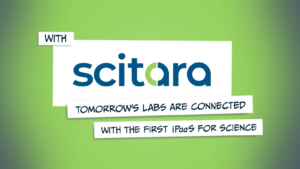The pharmaceutical industry is highly risk adverse due to the critical nature of ensuring the production of safe and effective products and medications, and therefore, can be cautious and resistant to change. It is only recently that the industry has begun to overcome some of the obstacles and hesitancy to modernize outdated laboratories, eliminate the traditional methods of manual data input, and drive operational efficiency into processes that lack connectivity and automation. Two things are moving the industry forward: a new generation of platforms that are beginning to transform the unconnected laboratory into a unified and highly efficient environment, and acceptance of Pharma 4.0 as the new paradigm of the pharmaceutical industry.
The Scitara’s iPaaS for Science And Digital Transformation
Pharmaceutical laboratories, guided by an ingrained cultural resistance to change, have largely consisted of a collection of efficient but disconnected processes, instruments and applications. While some have borrowed methodologies from other industries such as Six Sigma or Scrum theory to add a layer of efficiency and organization, the fact has remained that instrumentation and applications are still siloed, with the exception of bespoke, one-to-one connections dictated by each manufacturer. The result is a laboratory process that is slower than it needs to be, a reliance on manual transcription of data and manual processes, and a longer roll-out time that often impacts the bottom line.
Over the past two years, we have seen a “perfect storm” of events that have digitally transformed the pharmaceutical process, from R&D all the way through manufacturing and distribution. Some of this has been out of necessity – during the COVID pandemic, laboratories were under pressure to deliver faster than they ever have before, and that meant accepting newer innovations and processes and finding new ways to fit that digitalization into the existing regulatory and compliance framework. The digital transformation has also been driven by necessity as the industry faces an ever-increasing volume of data generated by an increasing amount of sophisticated instrumentation and applications, and the trend towards a distributed environment that includes CROs and CMOs often in multiple locations.
For the full realization and benefit of digital transformation to work, those larger amounts of data, a change in attitude and culture, and more advanced instruments and applications have to be guided by a unifying and transformative platform. Scitara’s iPaaS for science establishes that unification and sets out an efficient framework for digital transformation and the benefits of a Pharma 4.0 guided operation. It adds a flexible ecosystem that accelerates the delivery, accessibility and sharing of scientific data across the enterprise.
What is Pharma 4.0 – Why It Matters To Your Pharmaceutical Lab
Deriving the full benefit of Pharma 4.0 may start with a singular piece of technology, but it certainly does not end there. The International Society for Pharmaceutical Engineering (ISPE) Pharma 4.0™ Special Interest Group (SIG) explains that the foundation of Pharma 4.0 is built on data integrity, organization and processes, and culture – an important distinction, given that the move to Pharma 4.0 requires more than deployment of new technology and digitalization of process. It calls for a cultural shift throughout the business, and a combination of people, process, and technology to deliver measurable benefits.
The International Society for Pharmaceutical Engineering (ISPE) Pharma 4.0™ Special Interest Group (SIG) was created to understand Industry 4.0 and how it relates to the specific requirements of the pharmaceutical industry. As a result, Pharma 4.0 came into being to expand the principles of Industry 4.0 into a pharmaceutical environment. Pharma 4.0 represents the next phase in the industry, as pharma companies across the board catch up in embracing fourth-generation technologies and processes.
The Pharma 4.0 operating model, as defined by the ISPE, “…will connect everything, creating new levels of transparency and adaptivity for a digitalized plant floor. This will enable faster decision-making and provide in-line and in-time control over business, operations, and quality.”
That layer of connectivity has become reality with Scitara Digital Lab Exchange DLX™, the flagship component of Scitara’s iPaaS for Science, which brings a new paradigm of many-to-many connections, automation, improved accuracy, and end-to-end data integrity.
A results-oriented strategy for Pharma 4.0 based on Scitara DLX
More than anything, Pharma 4.0 is rooted in a holistic approach for an end-to-end digitalization of the pharmaceutical laboratory, differing from the dominant pharma lab model which relies mostly on multiple disconnected, vendor-specific, one-to-one data sharing paths. Scitara DLX defines the “no instrument or application left behind” model with a Pharma 4.0 approach to the laboratory, delivering on the ability to connect virtually anything – including legacy instruments – and fully digitalize the lab for maximum benefit.
Are you ready for a change? Meet the Modern Lab™.
Industry 4.0 has already changed the face of countless industries, and today Pharma 4.0, as defined by the ISPE and delivered by Scitara DLX, represents a transformative competitive advantage for pharma companies through faster decision-making, stronger process control, digitalization, automation, higher levels of quality, and monitoring and validation to ensure regulatory compliance.
